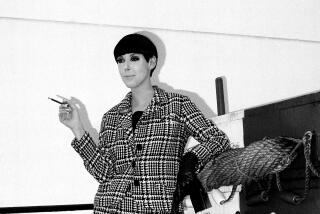John Casablancas dies at 70; transformed modeling business
- Share via
John Casablancas, the brash upstart who transformed the modeling business in the late 1970s when he founded the Elite agency and turned its young beauties — including Linda Evangelista, Gisele Bundchen and Naomi Campbell — into celebrities, died Saturday in Rio de Janeiro. He was 70.
Casablancas, who lived in Miami, had cancer, said his executive assistant, Lorraine Caggiano.
When Casablancas ventured into the modeling business in the early 1970s, the super-agents were Eileen Ford and Wilhemina Cooper, who took an old-school approach that included providing chaperones for their models and tucking them into bed at a reasonable hour.
FOR THE RECORD:
John Casablancas obituary: The obituary of Elite modeling agency founder John Casablancas in the July 23 LATExtra section misspelled the first name of Wilhelmina Cooper, who founded Wilhelmina Models, as Wilhemina.
Casablancas challenged their domination in 1977 when he moved his operation from Europe to New York City with a very different approach to grooming young women for the runway and glossy fashion spreads.
“We gave them huge amounts of money, and we gave them names and personalities. We let them give interviews. Suddenly, they became a dream for the larger public. They became supermodels,” he told the Chicago Sun-Times in 2000.
The main difference between his approach and Ford’s, he told another interviewer, was “Ford was a prude, and I was not.”
Through the 1980s and ‘90s, Casablancas’ vision gave Elite a coveted roster of talents who became household names and earned extravagant fees. Evangelista famously quipped that models at her level “don’t wake up for less than $10,000 a day.”
Casablancas later came to regret his role in turning models into superstars. In 2000, when he sold his share of Elite, he lashed out at the “spoilt trouble-makers” he had made famous. “I hate them all,” he said, singling out Bundchen as “a monster of selfishness” and Heidi Klum as “a German sausage without talent.”
“One of my biggest regrets is that I created the supermodel,” he told the Sun-Times. “They can be impossible. Impossible.”
When he left the agency it had 500 models on four continents whose bookings brought in $100 million a year.
Along the way the dashing Casablancas lived the high life he encouraged his models to pursue. He made no secret of his love of beautiful young women, dated many of his much-younger models and partied hard.
Married three times, he had an affair with model Stephanie Seymour in 1983, when she was 16 and he was 41. It ended his second marriage, to Jeanette Christjansen, a former model and Miss Denmark.
His retirement was hastened by a scandal involving the then-president of Elite Europe, Gerald Marie, who had been shown in a 1999 BBC documentary propositioning a young model to have sex with him. Casablancas was not implicated in the scandal, but he left the agency the following year.
Born in New York on Dec. 12, 1942, Casablancas had a cosmopolitan upbringing, which included attending the exclusive Swiss boarding school Le Rosey.
He attended several colleges to study law and economics but did not earn a degree.
“I used to fight with my father. When I fought, I went to work. If I made peace, I went to college.”
At 20 he was hired by the mother of a schoolmate to be a marketing manager for Coca-Cola in Brazil, even though he had no background in the area. At his father’s insistence he married his French girlfriend, Marie Christine, but the union did not last.
After a few years in Brazil, Casablancas moved to Paris, where his relationship with Christjansen bloomed. She suggested he try his hand at starting a modeling agency, so in 1969 he opened Elysees 3, named after his Paris phone number.
“Though it was years before Casablancas made his presence felt on an international level, modeling was never the same,” author Michael Gross wrote in his 1995 book “Model: The Ugly Business of Beautiful Women.”
“With Casablancas,” Gross wrote, “a new generation entered modeling. Raised on the new values of sex, drugs, and rock and roll, they were the children of ‘Blow-Up,’ and their arrival on the scene was explosive.”
In late 1971 the superagent announced he was opening a separate agency, Elite Model Management, to concentrate on top models.
Gross called the news “the birth announcement of the most important model agency since Ford.”
In 1977 Casablancas moved across the Atlantic to challenge Ford in her own backyard. His foray into New York spurred what came to be known as “the model wars.” The top agencies raided each other for talent, and Ford and Wilhemina sued Elite for infringing on their turf.
Over the next decade Casablancas turned Elite into a global network with a stable that would grow to include Cindy Crawford, Claudia Schiffer, Andie MacDowell, Iman and Paulina Porizkova.
He made headlines in 1993 when he fired Campbell. He later told a French magazine that Campbell “was odious. She used to go out every night with four different dresses in her bag and change in her car.”
Campbell later returned to Elite, but Casablancas continued to express disdain for supermodel egos and said that except for Evangelista, “no one ever thanked me for getting her to the top.”
Nonetheless, he said what had helped sustain him in the cutthroat business was its Pygmalion aspect.
“You can take a little girl who’s selling vegetables in Utah,” he once told the Chicago Tribune, “and six months later put her on the cover of Vogue.”
Casablancas is survived by his wife, Aline Wermelinger, and their three children, John Jr., Fernando Augusto and Nina. His other survivors include his children from his first two marriages, Cecile Casablancas and Julian Casablancas, the frontman for the band the Strokes; and a brother, Fernando.
More to Read
Start your day right
Sign up for Essential California for the L.A. Times biggest news, features and recommendations in your inbox six days a week.
You may occasionally receive promotional content from the Los Angeles Times.








